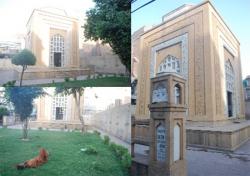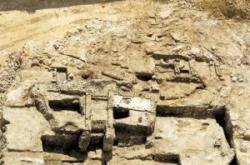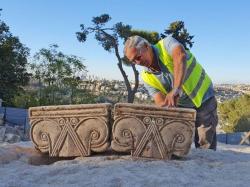INSTITUT SUPERIEUR D'ANTHROPOLOGIE
INSTITUTE OF ANTHROPOLOGY
ONLINE COURSES / COURS A DISTANCE
INSCRIPTION 2012 / Session III : Juillet 2012
REGISTRATION 2012 / Term III : July 2012
PAKISTAN –  Lahore - The condition of Sultan Qutbuddin Aibak’s tomb is very good and stable as compared to other historical monuments in Lahore. This magnificent historical monument is situated in Anarkali Bazaar. Qutbuddin was the first Muslim sultan of India and a successor of Shahabuddin Ghauri. The area of his graveside was earlier in open air. Rumour has it that the sultan was buried in the exact same place where he fell from a horse while playing chaugan (polo) in year 1210. This scribe visited the tomb and found that this was the only historical building that was very well maintained, preserved and restored as compared to other historical monuments of the city.
Lahore - The condition of Sultan Qutbuddin Aibak’s tomb is very good and stable as compared to other historical monuments in Lahore. This magnificent historical monument is situated in Anarkali Bazaar. Qutbuddin was the first Muslim sultan of India and a successor of Shahabuddin Ghauri. The area of his graveside was earlier in open air. Rumour has it that the sultan was buried in the exact same place where he fell from a horse while playing chaugan (polo) in year 1210. This scribe visited the tomb and found that this was the only historical building that was very well maintained, preserved and restored as compared to other historical monuments of the city.
http://www.dailytimes.com.pk/default.asp?page=2012%5C07%5C03%5Cstory_3-7-2012_pg13_4
LIBAN -  Beyrouth - The news of the destruction of an archaeological site presumed to be an ancient Phoenician port in downtown Beirut, estimated to be as old as the 5th century BC, took many Lebanese by surprise and in particular the Association for the Protection of the Lebanese Heritage, one of very few organizations in Lebanon struggling to protect historical heritage, and waging bitter legal battles against both private companies and the state.The site in question was bulldozed to the ground on Tuesday June 26th by the construction firm Venus apparently without any license or authorization, after culture minister Gaby Layoun gave a green light for the project to go ahead and build luxury towers on the site, overriding decrees promulgated by former administrations and that forbade any construction to take place at the contested site. A number of expert opinions on the other hand, made public by Francophone website Libnanews.com, offer a substantially different account from that of Pedersen’s report: In December 2011 three official statements were made: Prof. David Blackman, senior research fellow at the University of Oxford and former director of the British School of Archaeology in Athens wrote in a letter: “This is a discovery of great importance, both for the study of this type of site, which seems to appear in the Eastern Mediterranean in the late 6th century BC; and for the history of Beirut. I have been studying this type of site since the late 1960’s: I am therefore excited by this discovery, and I am concerned that the site must be preserved. There is no doubt about its identification as slipways and not simply quarries. I have not seen the site, but the reports are clear and convincing.” Prof. Dr. Jean-Yves Empereur, director of the Center for Alexandrian Studies (Centre National de la Recherche Scientifique) wrote: “I admire the beautiful discovery of a port in downtown Beirut. This new archaeological site dating back to 5th century BC is particularly important: It shows the quality of the great Phoenician civilization. While we count with fingers the remnants of such installations in the Greek world, this is a unique discovery which should be preserved and assessed, so that generations to come will be able to admire the achievements of their ancestors, the pioneers of maritime trade in the Mediterranean.” Dr. Kalliopi Baika, a maritime archaeologist for the Greek ministry of culture and tourism added: “The excavation site is even more important as the slipways and maritime installations unearthed were found in a well-dated context, which is rare for harbor works of this kind. In case it is decided to destroy the site and move the slipways, all this rich archaeological context will disappear.”
Beyrouth - The news of the destruction of an archaeological site presumed to be an ancient Phoenician port in downtown Beirut, estimated to be as old as the 5th century BC, took many Lebanese by surprise and in particular the Association for the Protection of the Lebanese Heritage, one of very few organizations in Lebanon struggling to protect historical heritage, and waging bitter legal battles against both private companies and the state.The site in question was bulldozed to the ground on Tuesday June 26th by the construction firm Venus apparently without any license or authorization, after culture minister Gaby Layoun gave a green light for the project to go ahead and build luxury towers on the site, overriding decrees promulgated by former administrations and that forbade any construction to take place at the contested site. A number of expert opinions on the other hand, made public by Francophone website Libnanews.com, offer a substantially different account from that of Pedersen’s report: In December 2011 three official statements were made: Prof. David Blackman, senior research fellow at the University of Oxford and former director of the British School of Archaeology in Athens wrote in a letter: “This is a discovery of great importance, both for the study of this type of site, which seems to appear in the Eastern Mediterranean in the late 6th century BC; and for the history of Beirut. I have been studying this type of site since the late 1960’s: I am therefore excited by this discovery, and I am concerned that the site must be preserved. There is no doubt about its identification as slipways and not simply quarries. I have not seen the site, but the reports are clear and convincing.” Prof. Dr. Jean-Yves Empereur, director of the Center for Alexandrian Studies (Centre National de la Recherche Scientifique) wrote: “I admire the beautiful discovery of a port in downtown Beirut. This new archaeological site dating back to 5th century BC is particularly important: It shows the quality of the great Phoenician civilization. While we count with fingers the remnants of such installations in the Greek world, this is a unique discovery which should be preserved and assessed, so that generations to come will be able to admire the achievements of their ancestors, the pioneers of maritime trade in the Mediterranean.” Dr. Kalliopi Baika, a maritime archaeologist for the Greek ministry of culture and tourism added: “The excavation site is even more important as the slipways and maritime installations unearthed were found in a well-dated context, which is rare for harbor works of this kind. In case it is decided to destroy the site and move the slipways, all this rich archaeological context will disappear.”
http://www.bikyamasr.com/71515/controversy-over-beiruts-phoenician-port/
ROYAUME UNI –  Gravesend - A Community archaeology dig will begin in Gravesend on Monday (July 9). The excavation, which is organised by Kent County Council, will be held at medieval Randall Manor, in the heart of the Shorne Woods Country Park. Volunteers and youngsters from schools in the area will unearth new treasures within the 13th Century manor, as part of the three-week project. Randall Manor was occupied for more than 100 years by the de Cobham family and although nothing survives above the ground, archaeologists began excavating the ruins 7 years ago. So far, they have unearthed the manor’s kitchen and the main buildings, where the Lord would have lived, and this is where focus will remain this year.
Gravesend - A Community archaeology dig will begin in Gravesend on Monday (July 9). The excavation, which is organised by Kent County Council, will be held at medieval Randall Manor, in the heart of the Shorne Woods Country Park. Volunteers and youngsters from schools in the area will unearth new treasures within the 13th Century manor, as part of the three-week project. Randall Manor was occupied for more than 100 years by the de Cobham family and although nothing survives above the ground, archaeologists began excavating the ruins 7 years ago. So far, they have unearthed the manor’s kitchen and the main buildings, where the Lord would have lived, and this is where focus will remain this year.
http://www.newsshopper.co.uk/news/9794830.Archaeology_dig_to_continue_at_Randall_Manor_in_Gravesend/
MALI –  Tombouctou - Islamist militants in Mali's historic city Timbuktu destroyed and damaged ancient sites for a third straight day, defying international threats of prosecution. Witnesses say the al-Qaida-linked group Ansar Dine targeted the 15th-century Sidi Yahya mosque on Monday, tearing off the entrance door. The door is considered sacred and was to remain closed until the end of the world. Timbuktu is home to 16 ancient mausoleums said to contain the remains of Muslim saints. The militants say Muslims should revere Allah, not saints, and are attacking the mausoleums with pickaxes and shovels. Timbuktu is a United Nations World Heritage site. The head of the Africa unit of the U.N.'s World Heritage Center, Lazare Eloundou Assomo, described the situation to VOA as serious and sad and said it is a tragedy for the world. “It is a tragedy for Africa because this heritage enables Africa to write its history. We understand African culture with Timbuktu treasures. There is no word for such action. It is unacceptable.” Timbuktu served as a center of Islam in Africa during the 15th and 16th centuries. It is also home to thousands of ancient manuscripts stored in libraries and homes under the care of religious scholars.
Tombouctou - Islamist militants in Mali's historic city Timbuktu destroyed and damaged ancient sites for a third straight day, defying international threats of prosecution. Witnesses say the al-Qaida-linked group Ansar Dine targeted the 15th-century Sidi Yahya mosque on Monday, tearing off the entrance door. The door is considered sacred and was to remain closed until the end of the world. Timbuktu is home to 16 ancient mausoleums said to contain the remains of Muslim saints. The militants say Muslims should revere Allah, not saints, and are attacking the mausoleums with pickaxes and shovels. Timbuktu is a United Nations World Heritage site. The head of the Africa unit of the U.N.'s World Heritage Center, Lazare Eloundou Assomo, described the situation to VOA as serious and sad and said it is a tragedy for the world. “It is a tragedy for Africa because this heritage enables Africa to write its history. We understand African culture with Timbuktu treasures. There is no word for such action. It is unacceptable.” Timbuktu served as a center of Islam in Africa during the 15th and 16th centuries. It is also home to thousands of ancient manuscripts stored in libraries and homes under the care of religious scholars.
http://blogs.voanews.com/breaking-news/2012/07/02/mali-islamists-destroy-ancient-timbuktu-sites-3/
PAKISTAN –  Mohenjo Daro - Pakistani officials say they are doing their best to save one of the most important archaeological sites in south Asia, Mohenjo Daro. But some experts fear the Bronze Age site could be lost unless radical steps are taken. In the lower town of Mohenjo Daro, where the middle and working classes once lived, the walls are crumbling from the base upwards. This is new damage. The salt content of the ground water is eating away at the bricks that, before excavation, had survived thousands of years. As we move to the upper town where the elite of the Indus civilization would have lived, and where some of the signature sites like the large public bath lie, it appears even worse. Some walls have collapsed completely, others seem to be close to doing so. "It is definitely a complicated site to protect, given the problems of salinity, humidity and rainfall," says Dr Ibrahim. "But most of the attempts at conservation by the authorities have been so bad and so amateur they have only accelerated the damage." One method used has been to cover all the brickwork across the vast site with mud slurry, in the hope the mud will absorb the salt and moisture. But where the mud has dried and crumbled, it has taken with it fragments of ancient brick, and the decay goes on underneath. We have to do something soon, because if things carry on like this, the site will not last more than 20 years”. There are even parts of the site where millennia-old bricks have been replaced with brand new ones. "In a way, it is testament to Mohenjo Daro that it is still standing, given everything that has been thrown at it in the last few decades in the name of conservation," says Dr Ibrahim.
Mohenjo Daro - Pakistani officials say they are doing their best to save one of the most important archaeological sites in south Asia, Mohenjo Daro. But some experts fear the Bronze Age site could be lost unless radical steps are taken. In the lower town of Mohenjo Daro, where the middle and working classes once lived, the walls are crumbling from the base upwards. This is new damage. The salt content of the ground water is eating away at the bricks that, before excavation, had survived thousands of years. As we move to the upper town where the elite of the Indus civilization would have lived, and where some of the signature sites like the large public bath lie, it appears even worse. Some walls have collapsed completely, others seem to be close to doing so. "It is definitely a complicated site to protect, given the problems of salinity, humidity and rainfall," says Dr Ibrahim. "But most of the attempts at conservation by the authorities have been so bad and so amateur they have only accelerated the damage." One method used has been to cover all the brickwork across the vast site with mud slurry, in the hope the mud will absorb the salt and moisture. But where the mud has dried and crumbled, it has taken with it fragments of ancient brick, and the decay goes on underneath. We have to do something soon, because if things carry on like this, the site will not last more than 20 years”. There are even parts of the site where millennia-old bricks have been replaced with brand new ones. "In a way, it is testament to Mohenjo Daro that it is still standing, given everything that has been thrown at it in the last few decades in the name of conservation," says Dr Ibrahim.
VIDEO = http://www.bbc.co.uk/news/magazine-18491900